The Marvelous Country
Samuel Cozzens (1875; rpt. 1967)
Today Arizona presents a sad spectacle, one that cannot fail to impress the beholder with wonder and regret; for its mute sentinels silently point to a civilization centuries old, which has not even the poor consolation of a history to record its rise and fall. (39)
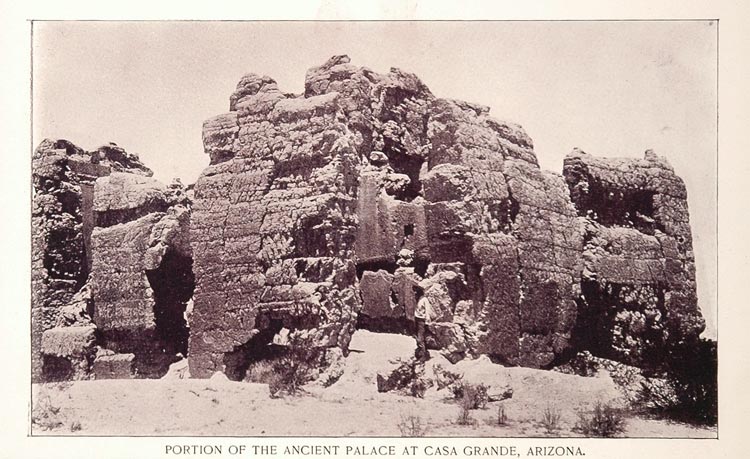
Certain it is that these mines have always been, and still are, the richest in the known world; they lack but one thing to make them the most valuable, and that is, protection to the miner. Do you ask me why, if these assertions are true, the Territory of Arizona is so little known? Why her mining wealth is, as yet, undeveloped by the present age? Let me tell you. The mines are mostly situated in the western and northern portions of the Territory, in the midst of the Apache country. (43)
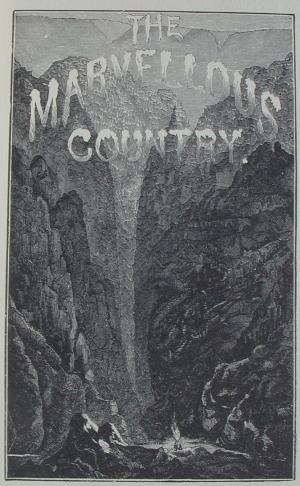
Remember, too, that Arizona never yet possessed a population of more than two thousand Americans, and those the worst class of gamblers, renegades, and cut-throats that could, by any possibility, be gathered together from the four quarters of the globe, a very large portion of whom sought a home in Arizona only when driven by the Vigilance Committees of Texas and California, to find some country where law was unknown, and justice recognized only so far as it suited the particular ideas of the party administering and who, under its sacred guise, assumed the right to gratify his worst passions, answerable only to the stronger, or most dexterous in the use of the bowie-knife, or pistol. (44-5)
Suddenly the appalling war-whoop of the Apaches sounded in our ears like a death-knell, echoed from side to side by the massive walls. It resembled the incarnate shrieks of ten thousand devils holding high carnival over the agony of some lost soul. (53)
Tortillas are made of corn, which is first soaked in a weak lye, and then boiled until it is perfectly soft, when it is crushed at a metatte, consisting of two flat stones, and afterwards moulded by the hands into a kind of pancake, and baked on a heated iron or stone. It is a very palatable article of food, and is undoubtedly a specimen of the unleavened bread mentioned in Scripture. (59)
Here we came upon the remains of a petrified forest, prostrate, and partially buried in a kind of red marl. Hundreds of trees lay here, and had been converted by some chemical process into specimens of variegated jasper. One tree that we saw measured ten feet in diameter, and was over a hundred feet in length. Some looked as if they had been charred by fire; their trunks were of a dark brown color, while the smaller branches and twigs were of a reddish hue. To me there was something impressively wonderful in this stupendous result of of Mother Nature's labors in her secret laboratory. Who should divine the cause? Who tell the history of the prostrate forest? How long has it there existed, and how many more centuries will it lie there undisturbed?
We brought away some beautiful specimens, although, owing to the depredations of our Apache friends, we were somewhat short of means of transportation. (76)
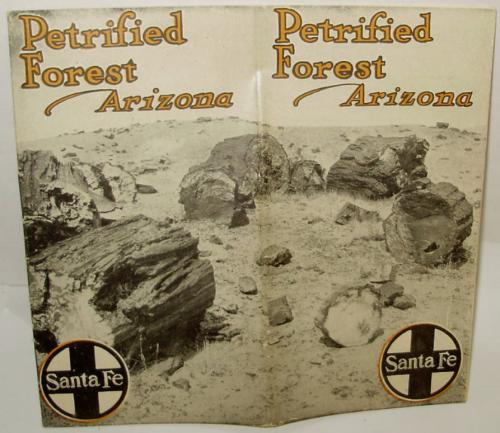
Dr. Parker feelingly alluded to the loss of his horse, and the miseries of a pedestrian life through such a rough country, and urged us, in case we should observe any appearance of petrifaction about him, not to leave him by the road-side, for the purpose of petrifying the traveller who came after us, but to give him Christian burial; and that for a headstone we should use a piece of the rock on which he split, with this inscription thereon: "Horseless and homeless a wanderer passed." (77)
We had hardly been two hours on our journey before we encountered "Jim" Davis. Now "Jim" Davis is a character, even in Arizona. (80)
An overland mail coach was occasionally attacked or an emigrant party massacred, and all the animals that could be stolen were driven off. Still, these years were regarded as quiet ones. And thus I was enabled to pursue my explorations in the Territory with but little annoyance during that time, especially as the since renowned Cochise was persuaded to act as my guide through portions of the Apache country rarely pressed by the foot of a white man. I first met Cochise at the "Apache Pass," a narrow gorge through the Chiricahui Mountains. (85)
After leaving the Chiricahui Mountains, Cochise, striking across the country in a northwesterly direction, soon came upon a trail; following this trail, we travelled all day over an alkali plain, which reflected the rays of the burning sun with an intensity that would have done credit to the moat highly-polished mirror. (98)

No more dreary and uninteresting country can be found under the sun, than that lying between the Apache Pass and Tucson. (143) [!?!]
Hastily rising, I proceeded to the bank of the aroya, where a sight met my gaze that for a moment astounded me. The aroya, which but a few hours before was parched and dry, was now filled nearly to the top of its banks with a torrent of dark, muddy water, rushing along at the rate of ten miles an hour, overturning immense rocks, and bearing upon its black and seething bosom trees, bushes, and stumps without number.
A moment's reflection convinced me that this aroya must be the natural outlet from the mountains, and the rain which had undoubtedly fallen in them during the evening, had collected in the water-courses and gullies upon their sides, and finally found vent through this channel to the plains below. (147-8)
Probably never before in the history of any country were gathered within the walls of a city such a complete assortment of horse-thieves, gamblers, murderers, vagrants, and villains, as were to be found in the city of Tucson. (153)
The miserable appearance of the city and its inhabitants determined us to get out of the town as soon as possible, and get out we did, early in the morning, Dr. Parker remarking that "there was little fear of our being salted for looking back, though if there ever was a place closely allied to old Sodom, it was Tucson." (154)
The Apaches, when on a raid or on the war-path, are allowed to eat but one meal a day, and to rest but three hours out of the twenty-four. Their discipline when on their excursions is splendid, quite equal to that of any army or civilized soldiers, while their ability to endure the hardships and discomforts of a campaign is far superior to that of white men. (170)
After much deliberation, and many arguments pro and con, Dr. Parker and myself finally decided to leave our wagon and mules at Tucson, in charge of Jimmy, and take the overland mail-coach to the Pimo villages on the Gila,—or swift running water,—from which place we determined to start on our visit to the celebrated "Casas Grandes" situated near that stream, which for many years have engaged the attention of the scientific men and savans of the Pacific coast. (184)
Arrangements having been concluded, we embarked about six o'clock in the morning, in one of Butterfield's coaches, for the Pimo villages, some ninety [sic; more like sixty] miles distant. (185)
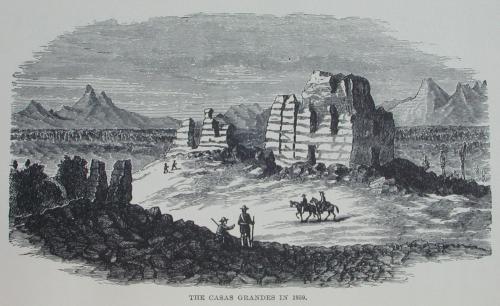
About noon we came in sight of three immense buildings, which our guide assured us were the "houses of Montezuma"; and we could but gaze upon them with wonder and awe, for never before had we seen anything so wonderful as these relics of un extinct race, of whom we have no reliable history, and no knowledge save traditionary legends.
The houses are situated on a slight eminence, and are about three or four hundred feet apart. They are built of species of concrete, made of mud and gravel, while the timber, or rafters, used in their construction, are of cedar, and well preserved.
The largest of these was, undoubtedly, at the time it was built, four stories in height; and there are walls now standing, to the height of fifty feet. (189-90)
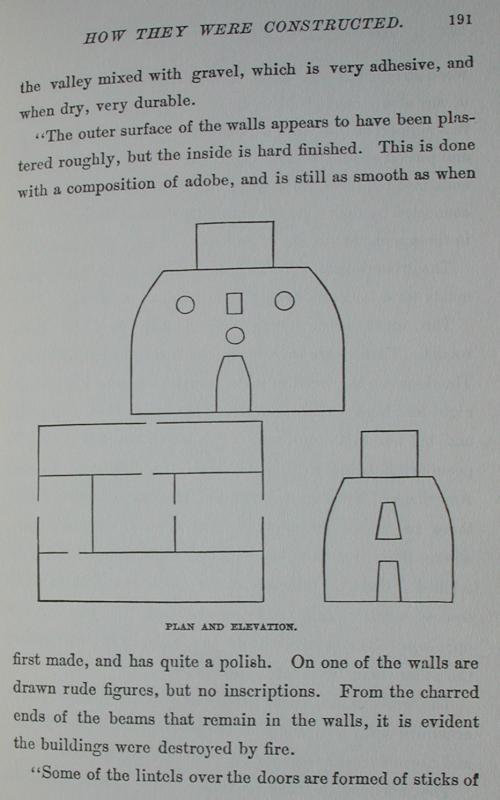
To the northwest, about two hundred yards distant, is a circular embankment, from two hundred and forty to three hundred feet in circumference, supposed to be the remains of a corral, or enclosure for cattle. (193) [More probably, a ball court.]
This was the condition in which Mangi and Father Kino found those ruins in 1674. In 1775, more than a hundred years later, Father Font describes them. Bartlett describes them as he found them in 1851. The writer found them in about the same condition in 1859, with the exception of the south wall, no part of which was then standing; all the remaining walls have upon them the hieroglyphics of ambitious Americans, who have greatly defaced the smooth polished surface by inscribing their names or marks upon them.
We were rather desirous of visiting the ruins on the Salinas, about forty miles above those of the "Casas Grandes"; but after repeated assurances from Mr. St. John and our Pimo guides, that the visit with so small a party would be the height of imprudence, and not caring to risk an encounter with the Apaches, we reluctantly turned our backs upon the ruins, en route once more for the Pimo villages, which we reached on the evening of the next day. (197-8)
[Felix Aubrey] published a journal of his travels in 1853, in which he tells of Indians that used gold for bullets in killing their game, whenever they were unable to obtain lead, a story which has since been corroborated by others who have attempted to penetrate into the country. In 1856, Aubrey set about organizing an expedition to visit the gold bearing portion of Central Arizona; but, before completing the undertaking, he was killed in a broil at Santa Fe. (201)
Within an hour after we left Colonel Johnson, a report reached us that he had been killed by our friend, Colonel Robinson, and so it proved.
As we stood beside the body, which, but an hour before, we had seen so full of life and activity, we could but feel that we had tarried at Tucson quite as long as we cared to, and were nothing loath to take our leave. We made no inquiries into the cause of the difficulty. The verdict of the people was, that Colonel Robinson was justified, and no further notice was taken of the affair. We had learned the lesson never to see or hear in Arizona, and it had more than once served us a good turn. (205-6)
For months afterwards this bow proved to be Jimmy's best card; for he related the story of his "capturin' it from an Apache, shure, wid these two hands, miself," many times, always forgetting to state, however, that the Apache was a dead one. (215-16)
These Apaches are certainly most adroit thieves, and manage to spirit off horses and cattle before the very eyes of their owners in the most unaccountable manner and without detection. To do this, however, they are sometimes obliged to crawl for a mile upon their bellies through the tall grass. After reaching the animal which they desire, they quietly unfasten his picket-pin and stealthily draw themselves up upon his side, clinging to his neck with their arms, thus effectually interposing his body, so as to act as a shield between them and his owner. While in this position they gradually and surely succeed in getting out of rifle range; then urging their prize into a gallop, they are soon out of sight, leaving the owner to wonder where his animal could have strayed to so suddenly. (221)
At the time of the author's residence in Arizona, the Territories of Arizona and New Mexico were one, and as one we propose to regard them, although in the year 1863 our sapient legislators at Washington, knowing about as much of the geographical formation of that country, or the real needs of its inhabitants, as a bear knows about Sunday Schools, declared the eastern boundary of the Territory of Arizona to be an imaginary line, supposed to run somewhere near the thirty-second degree of longitude west from Washington, and giving all that portion of the Territory east of said line, to New Mexico. (251)
Here we saw and talked for a long while with the veritable Kit Carson himself, a little weazen-faced, lighthaired, wiry, active frontierman, who wore his hair long, and. swore in a horrible jargon of Spanish and English, and who didn't "fear no Injun a livin'." (271)
One very singular fact in connection with the Moquis is deserving of especial mention, viz. the people of Harro, although living within two hundred yards of another large village,—the whole seven of these villages are within a radius of six miles,—speak an entirely different language from those of the remaining six villages, and seem to have preserved their manners and customs intact, as well as their language, for centuries; and another singular fact is, that while the people of Harro understand and can converse in the language spoken by the people of the other villages, they neither understand or can converse in the language spoken by the people of Harro. (466)
In any event, I shall be made happy by the knowledge that while you have been perusing these pages, you have at least gained some information concerning a section of our great country, almost as little known as though it did not exist, while in reality it is the most marvellous of all the many marvels that are to be found upon the North American Continent. (532)
|



